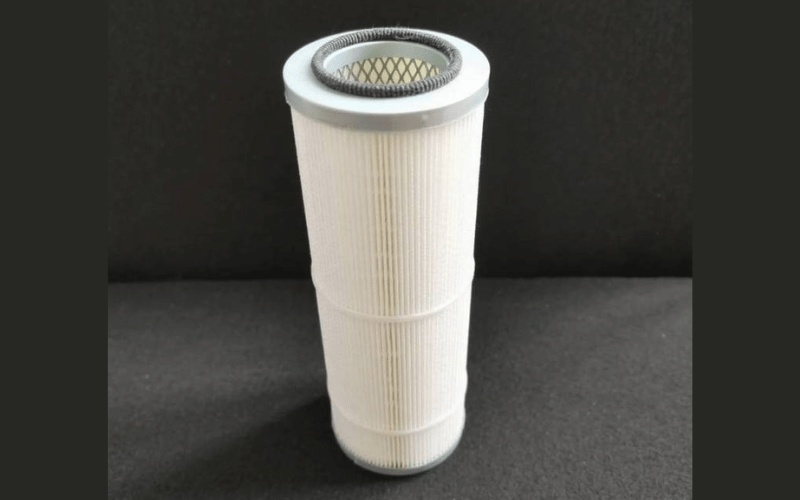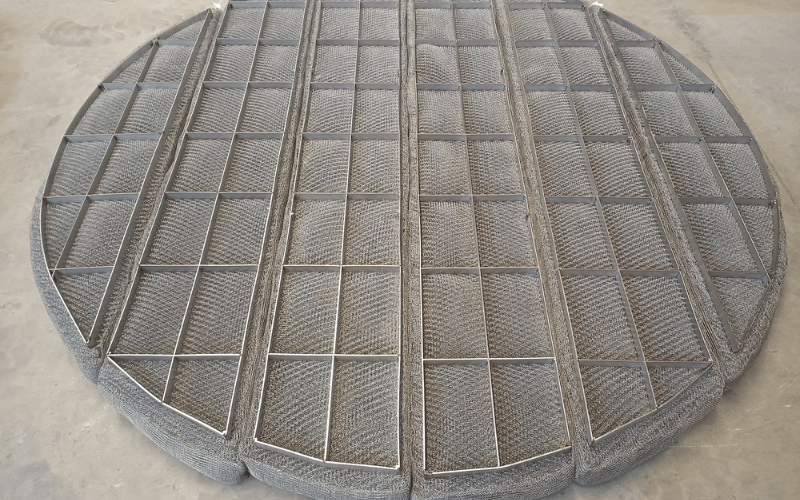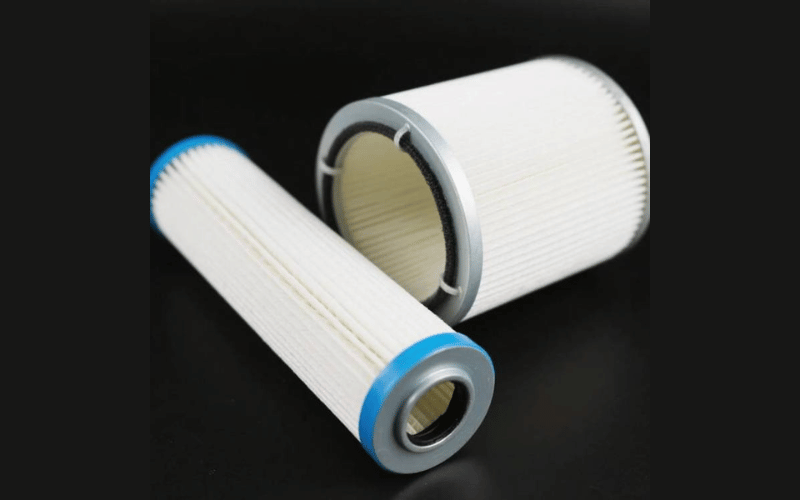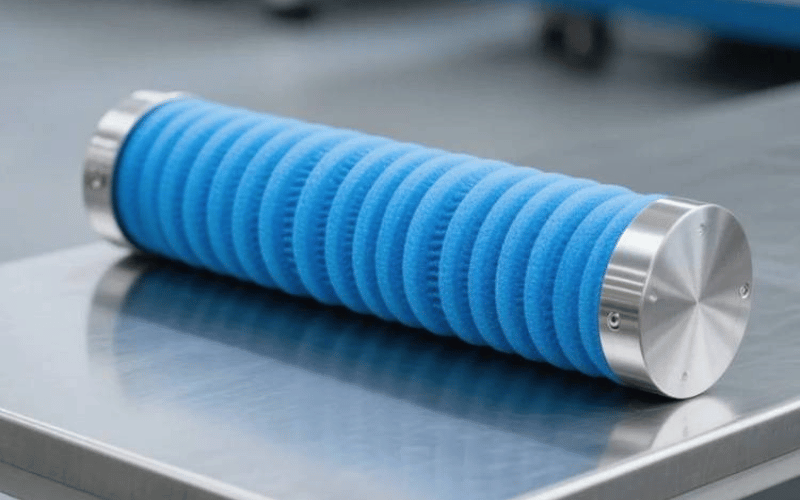Demister filters are essential components in air quality management systems, designed to remove liquid droplets, mist, and fine particles from gas streams. By utilizing advanced separation techniques, these filters ensure cleaner air, protect downstream equipment, and enhance the efficiency of industrial processes. Whether used in chemical plants, refineries, or HVAC systems, demister filters play a critical role in maintaining safe and healthy environments. Their ability to handle high-capacity operations while minimizing pressure drop makes them a reliable solution for industries prioritizing air quality and operational efficiency.
Table of Contents
ToggleUnderstanding Demister Filters
Demister filters, also known as mist eliminators, are essential components in industrial processes where the removal of liquid droplets from gas streams is critical. These devices are designed to enhance the efficiency of separation processes by capturing fine liquid particles suspended in gas, ensuring that gas streams are free from entrained liquid mist. Typically made from materials like stainless steel wire mesh or synthetic fibers, demister filters maximize surface area for effective droplet capture.
Widely used in industries such as chemical processing, oil and gas, and power generation, demister filters play a vital role in preventing liquid carryover, protecting downstream equipment, improving product quality, and reducing operational costs. They are commonly installed in process equipment like scrubbers, separators, and distillation columns, where they help maintain process integrity and ensure compliance with environmental regulations.

How Demister Filters Work?
Demister filters operate on the principle of impingement and coalescence. As the gas stream passes through the filter, liquid droplets collide with the filter material and adhere to its surface. Over time, these droplets coalesce to form larger droplets, which are heavy enough to fall out of the gas stream due to gravity.
The efficiency of a demister filter depends on several factors, including the filter design, the velocity of the gas stream, and the size of the liquid droplets. For optimal performance, the gas velocity must be carefully controlled to ensure that droplets are captured without causing excessive pressure drop.
There are two main types of demister filters: wire mesh and vane-type. Wire mesh demisters are made from interwoven metal or synthetic fibers and are ideal for capturing fine mist particles. Vane-type demisters, on the other hand, use a series of parallel plates or vanes to separate droplets from the gas stream. Each type has its advantages and is selected based on the specific requirements of the application.
Components of a Demister Filter Element
A demister filter element is composed of several key components, each designed to enhance its performance and durability. These components include:
- Filter Media:
The filter media is the core component of a demister filter. It is typically made from materials like stainless steel wire mesh, polypropylene, or other synthetic fibers. The choice of material depends on the operating conditions, such as temperature, pressure, and chemical exposure. Stainless steel is preferred for high-temperature and corrosive environments, while synthetic materials are suitable for less demanding applications. - Support Structure:
The support structure provides stability and ensures that the filter media maintains its shape during operation. It is usually made from metal frames or grids that are resistant to corrosion and mechanical stress. The support structure is critical for maintaining the integrity of the filter, especially in high-pressure applications. - Drainage Layer:
Some demister filters include a drainage layer to facilitate the removal of coalesced liquid droplets. This layer helps prevent liquid buildup within the filter, ensuring consistent performance and reducing the risk of clogging. - Housing or Frame:
The housing or frame encloses the filter element and provides a secure connection to the process equipment. It is designed to withstand the operating conditions and ensure a tight seal, preventing gas or liquid leaks.
Each of these components plays a vital role in the overall performance of the demister filter. By selecting the right materials and design, industries can achieve efficient droplet separation, protect their equipment, and maintain smooth operations.
Types of Demister Filters
Demister filters come in various designs and configurations, each tailored to specific industrial applications and operating conditions. These filters are essential for removing liquid droplets from gas streams, ensuring efficient separation and protecting downstream equipment. The choice of demister filter depends on factors such as the type of liquid, gas velocity, operating temperature, and pressure. Common types include wire mesh demisters, vane-type mist eliminators, and cyclone demister filters, each offering unique advantages for different processes.
Demister Pad vs. Mist Eliminator
While the terms “demister pad” and “mist eliminator” are often used interchangeably, they refer to slightly different components within separation systems.
Demister Pad:
A demister pad is a specific type of mist eliminator made from interwoven wire mesh or synthetic fibers. It is designed to capture fine liquid droplets from gas streams through impingement and coalescence. Demister pads are highly effective for applications that require the removal of fine mists, such as in distillation columns, scrubbers, and separators. They are lightweight, easy to install, and customizable in terms of material and size.

Mist Eliminator:
A mist eliminator is a broader term that encompasses various devices used to remove liquid droplets from gas streams. This includes demister pads, vane-type eliminators, and cyclone separators. Mist eliminators are selected based on the specific requirements of the application, such as droplet size, gas flow rate, and operating conditions.
The primary difference lies in their design and application. Demister pads are ideal for fine mist removal in low to moderate gas velocities, while other types of mist eliminators, such as vane or cyclone designs, are better suited for high-velocity or high-load applications.
Separator Design and Functionality
Separators are critical components in industrial processes, designed to separate liquid droplets, solids, or other impurities from gas streams. The design and functionality of a separator depend on the type of demister filter used and the specific requirements of the application.
Key Design Features:
- Inlet and Outlet Configuration: Separators are designed to optimize the flow of gas and liquid through the system. Proper inlet and outlet configurations ensure even distribution of the gas stream, reducing turbulence and enhancing separation efficiency.
- Internal Components: The internal components, such as demister pads or vane packs, play a crucial role in capturing and removing liquid droplets. These components are selected based on the size of the droplets and the desired separation efficiency.
- Drainage System: A well-designed drainage system ensures that coalesced liquid droplets are efficiently removed from the separator, preventing re-entrainment into the gas stream.
Functionality:
Separators work by slowing down the gas stream, allowing liquid droplets to collide with the filter media or internal components. The droplets coalesce into larger ones, which are then removed by gravity or centrifugal force. This process ensures that the gas stream exiting the separator is free from liquid contaminants, protecting downstream equipment and improving process efficiency.
Cyclone Demister Filters
Cyclone demister filters are a specialized type of mist eliminator that uses centrifugal force to separate liquid droplets from gas streams. These filters are particularly effective in high-velocity applications where traditional wire mesh or vane-type filters may not perform as efficiently.
How They Work:
Cyclone demister filters operate by introducing the gas stream into a cylindrical or conical chamber at high velocity. The gas is forced to spiral along the walls of the chamber, creating a centrifugal force that pushes liquid droplets outward. The droplets collect on the chamber walls and are drained away, while the clean gas exits through the center of the cyclone.
Advantages:
- High Efficiency: Cyclone filters are capable of removing a wide range of droplet sizes, including fine mists, with minimal pressure drop.
- Durability: These filters are designed to withstand high temperatures, pressures, and corrosive environments, making them suitable for demanding industrial applications.
- Low Maintenance: Cyclone demisters have no moving parts, reducing the need for frequent maintenance and ensuring long-term reliability.
Applications:
Cyclone demister filters are commonly used in industries such as oil and gas, chemical processing, and power generation. They are ideal for applications involving high gas velocities, heavy liquid loads, or corrosive conditions, where other types of mist eliminators may not be as effective.
By understanding the different types of demister filters and their specific applications, industries can select the most suitable solution to optimize their separation processes and maintain efficient operations.
Applications of Demister Filters
Demister filters are versatile components used across a wide range of industries to improve process efficiency, protect equipment, and ensure compliance with environmental standards. Their primary function is to remove liquid droplets from gas streams, but their applications extend far beyond this basic purpose. From industrial gas filtration to air quality improvement, demister filters play a critical role in maintaining operational reliability and safety.
Gas Filtration in Industrial Settings
In industrial environments, gas filtration is crucial for maintaining the purity of gas streams and safeguarding downstream equipment from contamination. Demister filters are widely used in processes where gas streams are laden with liquid droplets, such as in chemical plants, oil refineries, and power generation facilities.
For example, in chemical processing, demister filters are installed in scrubbers and distillation columns to remove liquid carryover, which can compromise product quality and damage equipment. Similarly, in oil and gas operations, these filters are used in separators to ensure that natural gas is free from liquid hydrocarbons and water vapor before it is transported or processed further.

The ability of demister filters to handle high gas velocities and varying droplet sizes makes them indispensable in industrial gas filtration. By capturing and removing liquid contaminants, they help maintain process efficiency, reduce maintenance costs, and extend the lifespan of critical equipment.
Liquid-Gas Separation Processes
Liquid-gas separation is a fundamental process in many industries, and demister filters play a crucial role in this operation. These filters are designed to separate liquid droplets from gas streams, ensuring that the gas is clean and free from impurities.
One common application is in natural gas processing, where demister filters are used to remove water and liquid hydrocarbons from the gas stream. This prevents corrosion in pipelines and ensures that the gas meets quality standards for commercial use. In the petrochemical industry, demister filters are employed in reactors and separators to remove liquid byproducts, improving the efficiency of chemical reactions and reducing waste.
Another critical application is in steam systems, where demister filters are used to remove water droplets from steam. This ensures that the steam is dry and suitable for use in turbines, heat exchangers, and other equipment. By preventing liquid carryover, these filters protect equipment from damage and improve overall system performance.
Enhancing Air Quality with Demister Filters
Demister filters also play a significant role in improving air quality, particularly in environments where air pollution is a concern. These filters are used in air scrubbers and ventilation systems to remove fine mist, aerosols, and other liquid particles from the air.
In industrial settings, demister filters help capture harmful emissions, such as oil mist and chemical vapors, before they are released into the atmosphere. This not only ensures compliance with environmental regulations but also protects workers from exposure to hazardous substances.
In HVAC systems, demister filters are used to improve indoor air quality by removing moisture and contaminants from the air. This is particularly important in environments like hospitals, laboratories, and cleanrooms, where maintaining clean and controlled air is critical.
By enhancing air quality, demister filters contribute to healthier and safer environments, both indoors and outdoors. Their ability to capture fine particles and prevent liquid carryover makes them an essential component in modern air filtration systems.
Factors Affecting Filtration Efficiency
Filtration efficiency is a critical aspect of any separation process, as it determines the effectiveness of removing liquid droplets or contaminants from gas streams. Several factors influence the performance of demister filters, including the filter design, operating conditions, and maintenance practices. Understanding these factors is essential for optimizing filtration systems and ensuring reliable operation in industrial applications.
Diameter of Filter Elements
The diameter of filter elements plays a significant role in determining the efficiency of a demister filter. Larger diameters provide a greater surface area for capturing liquid droplets, which enhances the filter’s ability to handle high gas flow rates and larger volumes of mist. Conversely, smaller diameters are better suited for applications requiring fine filtration, as they create smaller apertures that can trap finer particles.
The choice of filter element diameter depends on the specific requirements of the application. For instance, in high-capacity systems such as gas scrubbers or separators, larger filter elements are preferred to ensure efficient droplet removal without causing excessive pressure drop. On the other hand, processes requiring precision, such as pharmaceutical or food-grade filtration, may benefit from smaller, more tightly woven filter elements.
Additionally, the material and weave pattern of the filter element can further influence its performance. Stainless steel wire mesh, for example, is commonly used for its durability and ability to maintain structural integrity under high-pressure conditions. By selecting the appropriate diameter and material, industries can achieve optimal filtration efficiency tailored to their operational needs.
Operational Conditions and Gas Types
The operating conditions and the type of gas being filtered are crucial factors that impact the performance of demister filters. Variables such as gas velocity, temperature, pressure, and the presence of corrosive substances can all affect the filter’s efficiency and lifespan.
Gas Velocity:
Gas velocity must be carefully controlled to ensure effective droplet capture. If the velocity is too high, liquid droplets may pass through the filter without being captured, reducing filtration efficiency. Conversely, low gas velocity can lead to excessive pressure drop and reduced system performance.
Temperature and Pressure:
High temperatures and pressures can affect the structural integrity of the filter material. For applications involving extreme conditions, materials like stainless steel or high-performance alloys are recommended to ensure durability and consistent performance.
Corrosive Gases:
In environments where the gas stream contains corrosive substances, such as acids or chemicals, the filter material must be resistant to corrosion. Stainless steel grades like 316 or specialized coatings can provide the necessary protection, ensuring the filter’s longevity and reliability.
By considering these operational factors, industries can select the right demister filter and operating parameters to maximize efficiency and minimize downtime.
Maintenance of Demister Filters
Regular maintenance is essential for ensuring the long-term performance and efficiency of demister filters. Over time, filters can become clogged with captured liquid droplets, solid particles, or other contaminants, which can reduce their effectiveness and increase pressure drop.
Inspection and Cleaning:
Periodic inspection of the filter elements is necessary to identify signs of wear, corrosion, or clogging. Cleaning the filter elements can restore their performance and extend their lifespan. For wire mesh filters, cleaning methods such as backflushing or chemical cleaning are commonly used to remove accumulated debris.
Replacement of Worn Components:
In cases where the filter elements are damaged or excessively worn, replacement is necessary to maintain optimal filtration efficiency. Using high-quality replacement parts that match the original specifications ensures consistent performance and compatibility with the system.
Monitoring System Performance:
Installing monitoring equipment, such as pressure gauges or flow meters, can help track the performance of the filtration system. Sudden changes in pressure drop or flow rate may indicate issues with the filter, prompting timely maintenance or replacement.
By implementing a proactive maintenance program, industries can reduce operational disruptions, improve filtration efficiency, and extend the lifespan of their demister filters. Proper care and attention to these critical components ensure reliable performance in even the most demanding applications.
Frequently Asked Questions
Q: What is the function of a demister in gas-liquid separation?
A: A demister is a device used to remove liquid droplets from a gas stream. It works through mechanisms like inertial impaction, where larger droplets collide with a knitted wire or mesh pad and are effectively separated from the gas flow. This process improves product purity and protects downstream equipment from damage caused by liquid contamination.
Q: What are the benefits of using a PP demister pad?
A: A polypropylene (PP) demister pad offers excellent chemical resistance and temperature tolerance, making it ideal for use in highly contaminated environments like chemical processing plants and refineries. Its lightweight design and efficient droplet separation capabilities also help maintain optimal gas flow rates in filtration systems.
Q: How does a stainless steel demister pad compare to a plastic material demister?
A: Stainless steel demister pads provide superior durability, corrosion resistance, and a longer service life compared to plastic demisters, especially in harsh chemical environments. Plastic demisters, however, are more cost-effective and suitable for less corrosive applications where extreme durability is not required.
Q: What is the role of knitted wire mesh in a demister filter?
A: Knitted wire mesh is a key component in a demister filter, facilitating the separation of liquid droplets from gas streams. As the gas passes through the mesh, droplets collide with the wires, coalesce, and are removed. This ensures high separation efficiency and protects downstream equipment from liquid contamination.
Q: What are the different types of demisters available?
A: Common types of demisters include:
- Fiber Demister Pads: Effective for capturing fine droplets.
- Mesh Pad Mist Eliminators: Offer a balance between pressure drop and separation efficiency.
- Vane Separators: Designed for high-capacity applications and larger droplet removal.
Each type is tailored to specific industrial needs, ensuring optimal performance in various applications.
Q: How does temperature resistance affect demister performance?
A: Temperature resistance is crucial for demister performance, especially in high-temperature environments like power plants and refineries. A demister must retain its structural integrity and separation efficiency under extreme conditions to ensure effective liquid-gas separation and reliable operation.
Q: What is the significance of the pressure drop in demister filters?
A: Pressure drop refers to the reduction in pressure as gas flows through the demister filter. A low-pressure drop is desirable as it minimizes resistance to airflow, ensuring efficient system operation while maintaining high separation efficiency for liquid droplets.
Q: Can demisters be used in corrosive environments?
A: Yes, demisters can be used in corrosive environments when made from materials like Inconel or Monel 400, which offer excellent corrosion resistance. Choosing the right material ensures the demister’s durability and effectiveness in challenging conditions.
Q: What is the importance of droplet size in the design of demister filters?
A: Droplet size significantly influences the design and efficiency of demister filters. Smaller droplets (e.g., 3μm) are harder to capture due to their lower inertia, requiring specialized separation strategies. Understanding droplet size helps optimize the filter design for improved performance and efficiency.
Conclusion
Incorporating demister filters into air quality systems is a practical and effective way to improve air cleanliness and ensure the longevity of industrial equipment. These filters not only enhance the efficiency of liquid-gas separation but also contribute to safer working environments and compliance with environmental regulations. By selecting the right type of demister filter for specific applications, industries can achieve optimal performance and long-term reliability.


